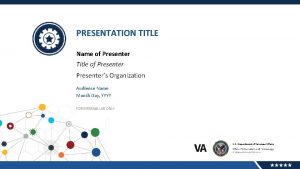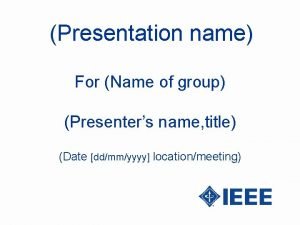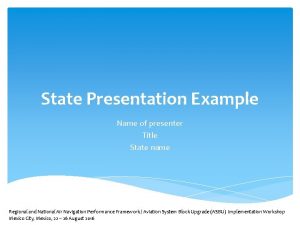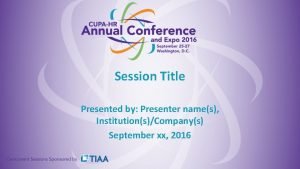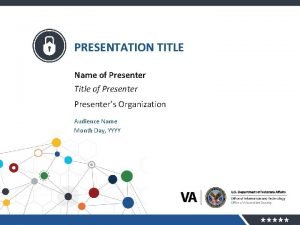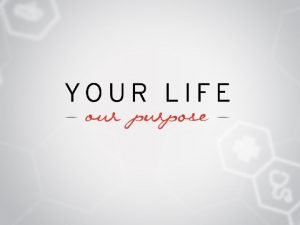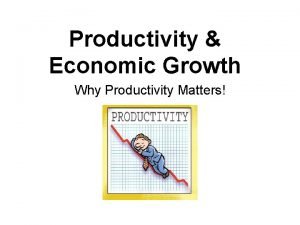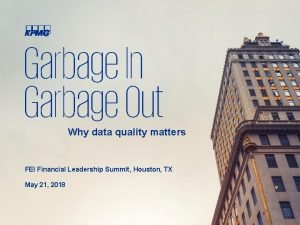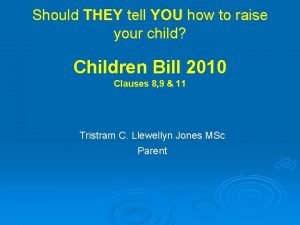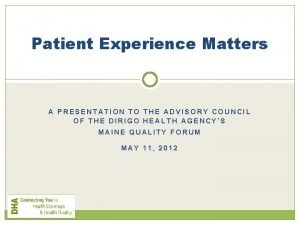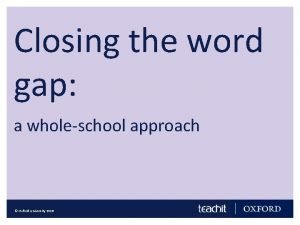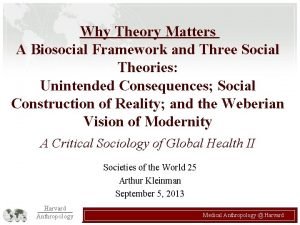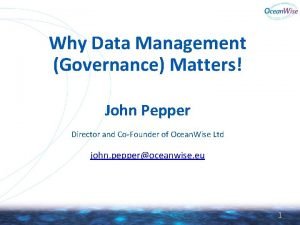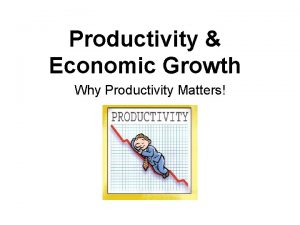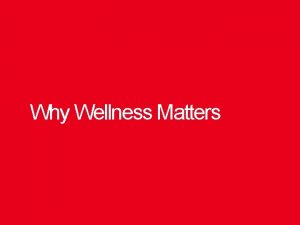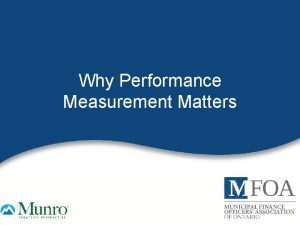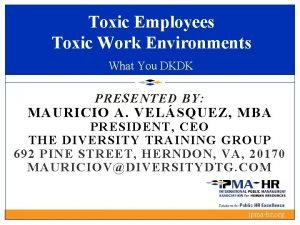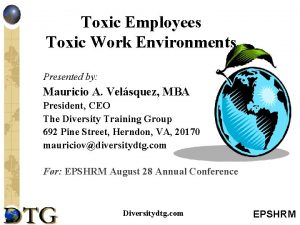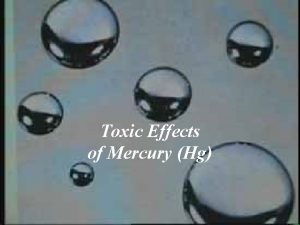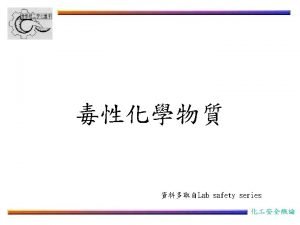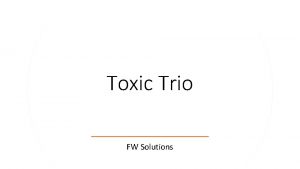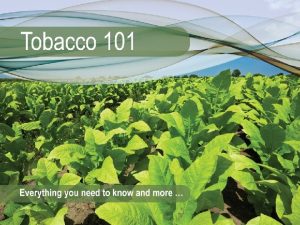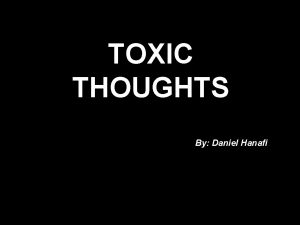Toxic Stress Why Environment Matters Name of Presenter


































- Slides: 34

Toxic Stress: Why Environment Matters Name of Presenter Material developed by the American Academy of Pediatrics Revised: August 2018

Objectives Participant will be able to: • Define adversity or stress • Describe 4 key concepts that help explain how environment-brain interaction changes the brain • Identify strategies for reducing toxic stress in order to promote healthy development

Why Does Environment Matter?

Development is a Dance Between Nature and Nurture From Bright Futures Guidelines for Health Supervision of Infants, Children and Adolescents, 4 th ed. : Modified with permission from Garner A, Forkey H, Stirling J, Nalven L, Schilling S; American Academy of Pediatrics, Dave Thomas Foundation for Adoption. Helping Foster and Adoptive Families Cope With Trauma. Elk Grove Village, IL: American Academy of Pediatrics; 2015. https: //www. aap. org/traumaguide. Accessed July 19, 2018.

Seeing the Environment Through an Ecobiodevelopmental (EBD) Framework • Promotes understanding of the environment and brain development • Shows why early support is important • Highlights psychosocial protective factors and stressors as every bit as biological as nutrition • Emphasizes the dimension of time

How Do You Define Adversity or Stress? • Stress is not necessarily a bad thing • Based on the perception and reaction (objective physiologic responses): – Positive stress response – Tolerable stress response – Toxic stress response Source: Toxic Stress. Center on the Developing Child at Harvard University Website. https: //developingchild. harvard. edu/science/key-concepts/toxic-stress/. Accessed on July 16, 2018.

Positive Stress Response • Brief, infrequent, mild to moderate intensity • Most normative childhood stress – 2 year-old stumbles while running – Beginning school or child care • Social emotional buffers allow a return to baseline • Builds motivation and resiliency • Positive Stress is not the absence of stress Source. Toxic Stress. Center on the Developing Child at Harvard University Website. https: //developingchild. harvard. edu/science/key-concepts/toxic-stress/. Accessed on July 16, 2018.

Tolerable Stress Response • Exposure to non-normative experiences – Death in family – Natural disaster • Social emotional buffers can provide protection and promote a return to baseline • A single major negative event does not necessarily mean long-lasting problems Source. Toxic Stress. Center on the Developing Child at Harvard University Website. https: //developingchild. harvard. edu/science/key-concepts/toxic-stress/. Accessed on July 16, 2018.

Toxic Stress Response • Long lasting, unremitting stress, not a “single bad stressor” • Adverse child experiences – Abuse – Household dysfunction • • Insufficient social-emotional buffering Potentially permanent changes and long-term effects Epigenetics Brain architecture Source Toxic Stress. Center on the Developing Child at Harvard University Website. https: //developingchild. harvard. edu/science/key-concepts/toxic-stress/. Accessed on July 16, 2018.

“Social-emotional buffering is the primary factor distinguishing tolerable from toxic level of stress. ” Andrew Garner, MD, Ph. D, FAAP Chair, AAP EBCD Leadership Work Group (2012 -2014)

Desired Protective Factors For Families Concrete support in times of need Social connections Knowledge of parenting and child development Personal resilience The ability to enhance social and emotional competence in children • The ability to foster nurturing and attachment • • • Strengthening Families: A Protective Factors Framework. Center for the Study of Social Policy. https: //www. cssp. org/young-children-their-families/strengtheningfamilies/about#protective-factors-framework. Accessed July 26, 2018.

Desired Protective Factors For Communities Safe neighborhoods Safe, high quality schools Stable and safe housing Access to nutritious food Access to job opportunities Access to medical care (including behavioral health and wellness care) • Access to transportation • Access to safe, high quality, affordable child care • Inclusion and equity related to race, ethnicity, and disability • • • Strengthening Families: A Protective Factors Framework. Center for the Study of Social Policy. https: //www. cssp. org/young-childrentheir-families/strengtheningfamilies/about#protective-factors-framework. Accessed July 26, 2018.

Eco-Bio-Developmental Model of Human Health and Disease Ecology becomes biology, And together they drive development across the lifespan Shonkoff JP, Garner AS, American Academy of Pediatrics Committee on Psychosocial Aspects of Child and Family Health, Committee on Early Childhood, Adoption, and Dependent Care, Section on Developmental and Behavioral Pediatrics. The lifelong effects of early childhood adversity and toxic stress. Pediatrics. 2012; 129(1): e 232 -e 246. doi: 10. 1542/peds. 2011 -2663.

Precipitants and Consequences of Stress in Childhood Bright Futures Guidelines for Health Supervision of Infants, Children and Adolescents, 4 th ed. : Reproduced with permission from Garner A, Forkey H, Stirling J, Nalven L, Schilling S; American Academy of Pediatrics, Dave Thomas Foundation for Adoption. Helping Foster and Adoptive Families Cope With Trauma. Elk Grove Village, IL: American Academy of Pediatrics; 2015. https: //www. aap. org/traumaguide. Accessed July 2018.

Key Concept 1 Childhood adversity has lifelong consequences

Adverse Childhood Experiences (ACE) Study • One the largest studies to assess associations between childhood maltreatment and later health and well-being • Findings suggest that certain experiences are major risk factors for illnesses and poor quality of life Violence Prevention: Adverse Childhood Experiences (ACEs). Centers for Disease Control and Prevention Website. https: //www. cdc. gov/violenceprevention/acestudy/. Updated April 1, 2016. Accessed July 16, 2018.

Adverse Childhood Experiences (ACE) Study The Ace Pyramid. Centers for Disease Control and Prevention Website. https: //www. cdc. gov/violenceprevention/acestudy/about. html. Updated June 14, 2016. Accessed July 13, 2018.

Key Concept 2 Epigenetics • Which genes are turned on/off, when and where • Ecology (environment/experiences) • Stress-induced changes in gene expression

Parental Stress and Children’s Genes • Parents’ stress leaves lasting marks on children’s genes • Higher stress levels reported by mothers during their child’s first year correlated with methylation levels on 139 DNA sites in adolescents Parent' stress leaves lasting marks on children's genes: UBC-CFRI research. The University of British Columbia Website. https: //news. ubc. ca/2011/08/30/parents-stress-leaves-lasting-marks-on-childrensgenes-ubc-cfri-research/. Published August 20, 2011. Accessed July 17, 2018.

Hippocampus Volume by Preschool Depression Severity and Maternal Support Luby J L et al. PNAS 2012; 109: 2854 -2859 © 2012 by National Academy of Sciences Luby JL, Barch DM, Belden A, et al. Maternal support in early childhood predicts larger hippocampal volumes at school age. PNAS. 2012; 109(8): 2854 -2859. doi: 10. 1073/pnas. 1118003109

Key Concept 3 Developmental Neuroscience • Brain architecture is experience-dependent • Ecology influences how brain architecture is formed and remodeled • Diminishing cellular plasticity limits remediation

5 Principles of Brain Development • • • Experience dependent Cumulative Integrated Dynamic Asynchronous Garner A, Saul R. Thinking Developmentally. Itasca, IL: American Academy of Pediatrics; 2018.

Plasticity • Plasticity refers to the brain’s unique ability to literally “rewire” itself in response to experience • Experience influences not only the foundational architecture, but the on-going connectivity and functionality • Two different types of plasticity… Garner A, Saul R. Thinking Developmentally. Itasca, IL: American Academy of Pediatrics; 2018.

Plasticity • Synaptic Plasticity – Variation in the STRENGTH of individual connections – “a single person goes from a whisper to a shout” – Lifelong (how old dogs learn new tricks) • Cellular Plasticity – Variations in the NUMBER (or COUNT) of connections – “from one person shouting to a stadium shouting” – Declines dramatically with age (waning by age 5) Garner A, Saul R. Thinking Developmentally. Itasca, IL: American Academy of Pediatrics; 2018.

Differential Maturation The Brake – PFC (with some hippocampal help) Frontal lobes: Abstract thought, reasoning, judgment, planning, impulse and affect regulation, consequences Parietal Lobe: Integration of sensory data and movement Temporal lobe (outside): Processing sound and language Occipital Lobe: Visual processing Limbic System (inside): Emotions and impulsivity + The Gas Pedal + Amygdala Cerebellum: Smooth movements Coordination Brain Stem & Cranial Nerves: Vital functions Swallowing Adapted from: Garner A, Saul R. Thinking Developmentally. Itasca, IL: American Academy of Pediatrics; 2018. p. 44

Impact of Early Stress CHILDHOOD TOXIC STRESS Hyper-responsive stress response; calm/coping Chronic “fight or flight; ” cortisol / norepinephrine Changes in Brain Architecture Garner A, Saul R. Thinking Developmentally. Itasca, IL: American Academy of Pediatrics; 2018.

Critical Concept 4 What can you do to make it better?

Development is a Dance Between Nature and Nurture • What you can do: – Apply an ecobiodevelopmental framework – Recognize adverse psychosocial factors – Collaborate with families and social service providers – Conduct developmental and behavioral monitoring and screening

Early Connections Form the Foundation • What you can do: – Encourage social-emotional skills – Talk about the 5 Rs of early education – Help families recognize social and developmental milestones

Promoting EBCD The First 1000 Days: Examples for Promoting EBCD Consistent with Bright Futures Guidelines for Health Supervision of Infants, Children and Adolescents, 4 th ed. https: //www. aap. org/en-us/advocacy-andpolicy/aap-health-initiatives/EBCD/Documents/EBCD_Well_Child_Grid. pdf , Accessed August 28, 2018

Strategies to Improve Developmental Trajectories E V I S T N C E TIO T O PR RVEN E T N I Anticipatory Guidance Additional Strategies for ‘At Risk’ Families • High Quality ECE • Language Stimulation • Parent Responsiveness Additional Strategies for ‘Poor Health’ Families • Home visiting • Specialized Services Source: Halfon N, Larson K, Lu M, Tullis E, Russ S. Lifecourse Health Development: Past, Present and Future. Matern Child Health J. 2014; 18(2): 344 -365. doi: 10. 1007/s 10995 -013 -1346 -2.

Brain Plasticity Declines With Age • What you can do: – Work with families and child care providers to ensure that brain’s wiring is right the first time – Advocate for a public health approach to toxic stress – Help families to provide safe, stable relationships – Assist families in regulating stress Garner A, Saul R. Thinking Developmentally. Itasca, IL: American Academy of Pediatrics; 2018.

Conclusion: It is easier to build strong children than to repair broken men. Frederick Douglass

Questions?
 Hey bye bye
Hey bye bye Aspartate-argininosuccinate shunt
Aspartate-argininosuccinate shunt Presented by name
Presented by name Presenter name
Presenter name Presenter name
Presenter name Presenter name
Presenter name Presenter's name
Presenter's name Presenter name
Presenter name Name/title of presenter
Name/title of presenter Name of the presenter
Name of the presenter Presenter name
Presenter name Presenter name
Presenter name Younique presenter ms name
Younique presenter ms name Name/title of presenter
Name/title of presenter Presenter's name
Presenter's name Title of presenter
Title of presenter Presenter's name
Presenter's name Presenter name
Presenter name Name/title of presenter
Name/title of presenter Cs391r
Cs391r Presenter name
Presenter name Title
Title Presenter's name
Presenter's name Presentation name
Presentation name Presenter name
Presenter name Presenter's name
Presenter's name Why punctuation matters
Why punctuation matters Why productivity matters
Why productivity matters Standard data quality dimensions kpmg
Standard data quality dimensions kpmg Why was every child matters scrapped
Why was every child matters scrapped Why patient experience matters
Why patient experience matters Closing the word gap
Closing the word gap Why theory matters
Why theory matters Why data governance matters
Why data governance matters Why productivity matters
Why productivity matters




